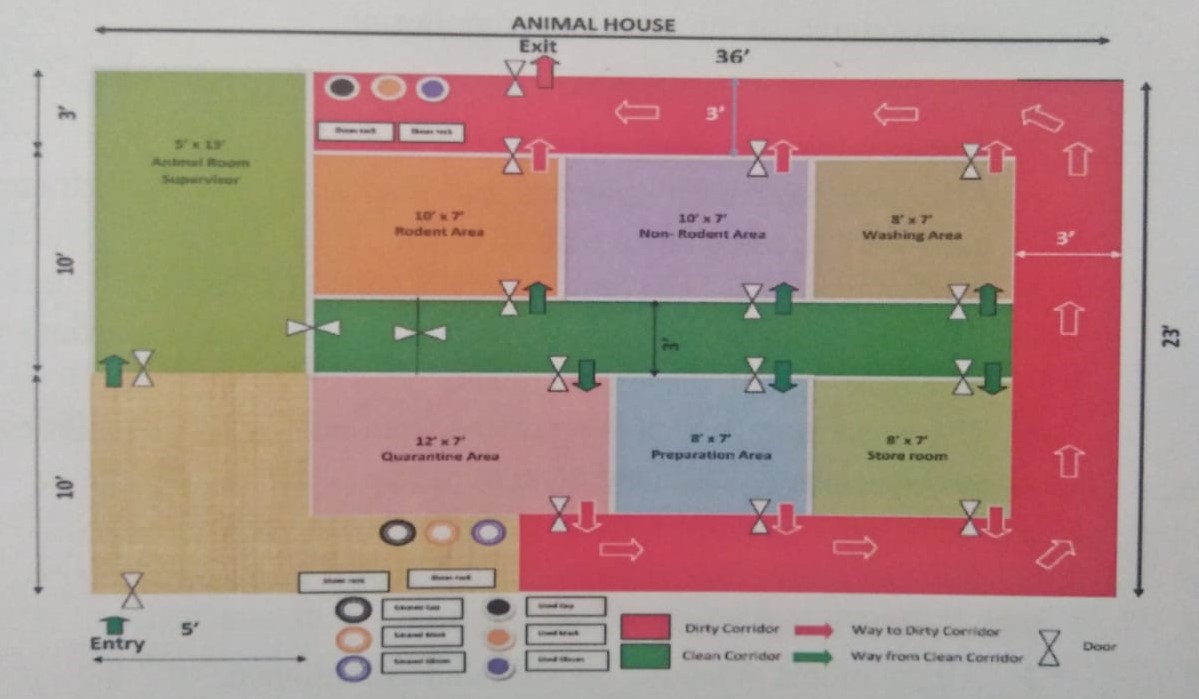ANIMAL HOUSE FACILITY
Animal House & related facilities
- Dimensions of Animal house
The area of our animal house is 105 square meter. - Sterilisation facility for feed, cages etc
Water of at least 82.2C (180F) or appropriated chemicals agents (e.g. hyperchlorite) to destroy pathogenic organisms have been used for sterilizing. - Water bottles, sipper tubes, stoppers, and other watering equipment have been washed and then sanitized by rinsing with water of at least 82.2C (180F) or appropriated chemicals agents (e.g. hyperchlorite) to destroy pathogenic organisms, and provision Cages have been disinfected by rinsing at a temperature of 82.2 C (180 F) or higher for a period long enough to ensure the destruction of vegetative pathogenic organisms.
- Cages of Rabbits, guinea pigs and hamsters have been treated with acid solutions before washing.
- Periodic microbiologic monitoring is done to determine the efficacy of disinfection or sterilization procedures.
- An autoclave is available and is being used when pathogenic organisms are present.
- Deodorizers or chemical agents other than germicidal have not been used to mask animal odors.
Washing facilities and sanitation conditions:
- Animal rooms, corridors, storage spaces, and other areas have been cleaned with appropriate detergents and disinfectants as often as necessary to keep them free of dirt, debris, and harmful contamination.
- Old water bottles have been replaced with new bottles each time of feeding water on the feeding cage
- A two – compartment sink is available for dipping or soaking the water bottles in detergents and disinfectant solutions.
- Racks, and accessory equipments, such as feeders and watering devices, have been washed and sanitized frequently to keep them clean and contamination free.
- Accessories – washed and cleaned twice a week .
- Cages, Racks–Washed and cleaned at least monthly.Assessing the effectiveness of sanitation: –
- Monitoring of sanitation practices have been done to the process and materials being cleaned; it includes visual inspection of the materials, monitoring of water temperatures, or microbiologic monitoring.
Disposal of animals after experimentation as per norms:
- Wastes have been removed regularly and frequently.
- All waste have been collected and disposed of using incineration. Incinerators used were in compliance with all central, state, and local regulations.
- Animal waste has been removed by hosting or flushing at least twice a day.
- Waste cans containing animal tissues, carcasses, and hazardous wastes were lined with leak – proof, disposable liners.
- The waste storage area is separated from other storage facilities and free of flies, cockroaches, rodents, and other vermin.
Air conditioning /handling/circulation/facilities: – (04)
Temperature and humidity control
- All the rooms of animal house are air-conditioned.
- The temperature of 25º±2 ºC is provided throughout the year.
- Capability is provided to allow variationswithin the range of approximately 18 to 29 °C (64.4 to 84.2 ºF), which includes the temperature ranges usually recommended for common laboratory animals.
- The relative humidity of 45 – 55% is provided throughout the year.
- The relative humidity is controllable within the range of 30% to 70%throughout the year.
- For larger animals a comfortable zone (18 to 37 °C) is be maintained during extreme summer by appropriate methods for cooling.
Power and lighting
- A time-controlled lighting system is used to ensure a regular diurnal lighting cycle (12:12) wherever required. 12 hours in light and 12 hours in dark
- Fluorescent tube lights are used with the intensity of 350-400 lux 1 meter above the floor level.
- Emergency power is available in the event of power failure.
Noise control
- The rooms in the animal house are made with the concrete walls to provide the noise free environment.
Registration of Institutional Animal Ethics Committee:
- Our Institutional Animal Ethical Committee have got registered in the CPCSEA.
- The registration number is 1844/PO/Re/S/15/ CPCSEA.
Institutional Animal Ethical Committee
Animal House Facility is registered with Committee for the Purpose of Control and Supervision of Experiments on Animals (CPCSEA), Govt. of India, Ministry of Environment, Forest & Climate Change, Animal Welfare Division, New Delhi, vide Registration No.: 1884/PO/Re/S/15/CPCSEA dated 30.12.2015.
The Animal House is conventional type of animal house with each species housed in individual rooms, in which the temperature, humidity, dark and light cycles are monitored. Microbiological / health monitoring is done regularly.
The animal house facility is available to boost the teaching, training and research facilities and to meet the growing demand for high quality laboratory animals in emergent field of Experimental Pharmacology. Qualified veterinarians and technical personnel are always at hand to help carry out research.
Animal care
The laboratory houses rats, mice and rabbits. Each species of animals is housed in barrier maintained individual rooms to avoid disease transmission and inter-species conflicts. All efforts are made to maintain the animals under controlled environmental conditions [Temperature (22-26°C), Relative Humidity (60 ± 10 %), 12 hr alternate light and dark cycle] with 100 % fresh air exchange in animal rooms and uninterrupted power and water supply. The support staffs ensures that every part of animal care including feeding, watering, restraining, cage cleaning, record keeping and ordering of animals, feeds, bedding materials and equipment from outside sources are monitored. The animals themselves are isolated from human habitation and guarded from dust, smoke, noise, wild rodents, insects and birds-in fact anything that would disturb their habitat. A high degree of hygienic conditions (macro- and micro- environment) around the animals are maintained as per the CPCSEA guidelines.
Veterinary care
Periodic health monitoring of the animals is carried out to ascertain the heath status of the animals. Veterinary care is crucial to keep the animals content and healthy. The veterinarian keeps them under daily observation and monitors any behavioural changes or signs of illness. He supervises their diet and sanitation and contributes to the formulation of appropriate policies and procedures for ancillary aspects of veterinary care.
Animal ethics
The Animal House is registered with the Committee for the Purpose of Control and Supervision of Experiments on Animals (CPCSEA), Ministry of Environment and Forests, Govt. of India (Reg. No.1884/PO/Re/S/15/CPCSEA) and has an established Institutional Animal Ethics Committee (IAEC) that advises the students, teachers/researchers on facilities, policies and practices concerning the care and use of animals.
Working Hours
The Animal House Facility operates all the days round the year including Sundays and closed holidays.
The timings are – Monday – Saturday (Weekdays) : 09:00 AM to 05:00 PM
– Sunday and Closed Holidays: 09:00 AM to 12:00 PM
Other Important Links
- CPCSEA – RenewalLetter
- The Prevention of Cruelty to Animals Act- 1960
http://www.envfor.nic.in/legis/awbi/awbi01.html
- The Breeding of and Experiments on Animals (Control and Supervision) Rules, 1998
http://envfor.nic.in/legis/awbi/awbi10.html
- CPCSEA Guidelines for Laboratory Animal Facility
http://envfor.nic.in/divisions/awd/cpcsea_laboratory.pdf
- The Recommendations of the ‘Sub-Committee on the Rehabilitation of Animals after Experiments’ setup by CPCSEA
http://envfor.nic.in/divisions/awd/Rehabiliaion_Guidelines_new.pdf
- Bio-Medical Waste (Management and Handling) Rules, 1998
http://envfor.nic.in/legis/hsm/biomed.html
- Bio-Medical Waste (Management and Handling) Rules, Amendment 2003
http://envfor.nic.in/legis/hsm/so-1069(e).pdf
FORMS and FORMATS
- Application for the Permission of Animal Experiments (from IAEC/CPCSEA) (Form B)
- Record of Animals Bred/Acquired/Transfer (Form C)
- Record of Animals Acquired and Experiments Performed (Form D)







